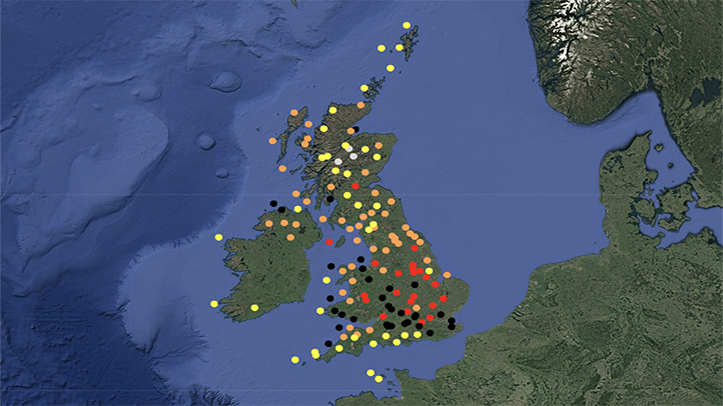The Sustainable Control of Parasites in Sheep (SCOPS) Group is once again offering its invaluable Nematodirus Forecast to help farmers, vets and advisors identify when lambs might be at risk of exposure to nematodirus, ensuring timely and effective interventions.
Speaking on behalf of SCOPS, independent sheep consultant Nerys Wright said: “The SCOPS Nematodirus Forecast is an essential tool due to the role of temperature on the larvae of this worm species. This year in particular we have seen some significant fluctuations in temperatures, making the time of hatching difficult to predict without the forecast.
“Currently, the map indicates there are some very high risk areas, as marked by black dots, which is earlier than in previous years. Lambs born from mid-February onwards that are old enough to be grazing are currently at the highest risk. Most March-born lambs are currently too young to be affected.”
Analysis of historic forecast data from 2019 to 2024 highlights the variation in the timing of the nematodirus hatch, corresponding to temperature fluctuations.
Dr Wright added: “The range between the earliest and latest onset of very high-risk varies by six to seven weeks over a five-year period, highlighting that treatment at set times is unlikely to be effective.
“Neither can we risk a wait-and-see approach because when an outbreak occurs, as Nematodirus can rapidly cause severe harm or even death to a large number of lambs. The forecast helps to pinpoint the timing of any treatment given.”
Nematodirus eggs already on the pasture from last year’s lambs typically require a period of cold weather followed by warmer temperatures of 10°C or more to hatch. If these conditions occur in quick succession, it can trigger a mass hatch. If this coincides with lambs beginning to consume significant amounts of grass (at around six weeks of age) the impact can be devastating.
By using the SCOPS Nematodirus Forecast in combination with grazing history, aspect and altitude for each group of lambs, farmers can better assess the risk of nematodirus infection and take timely preventive measures.
Dr Wright continued: “It’s important to note that faecal egg counts (FECs) are not a reliable indicator of current risk. The damage is caused by immature larvae that do not produce eggs and will not be found in samples.”
The SCOPS forecast predicts the hatching of Nematodirus battus based on local weather conditions. The interactive map, updated daily with data from 140 weather stations (Met Office and DarkSky), provides a guide to the risk level in your area.
To assess the risk for each group of your lambs, consider the field’s history, aspect, and altitude. South-facing fields typically experience earlier hatching, and for every 100m (328ft) increase in altitude hatching is delayed by about seven days.
For example, if your nearest weather station is at 200m (656ft) and your farm is at 100m (328ft), hatching could occur around seven days earlier than the forecast on your farm.
Dr Wright recommended producers speak to their vet, SQP or animal health advisor about this topic and visit the SCOPS website.


